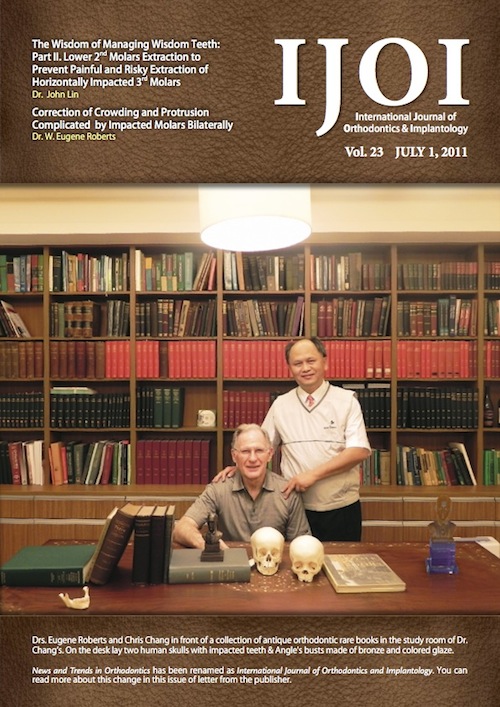IJOI Vol. 23

The Wisdom of Managing Wisdom Teeth
Part II. Lower 2nd Molars Extraction to Prevent Painful and
Risky Extraction of Horizontally Impacted 3rd Molars
Lin JJ
Introduction
It is almost a routine practice to remove malposed impacted lower 3rd molars for the following reasons: pericoronitis, proximal caries or periodontal pocket formation due to difficulty in cleaning space between lower 2nd and 3rd molars. Some may also argue they could cause post orthodontic treatment crowding. (Int J Orthod Implantol 2011;23:4-17)
Correction of Crowding and Protrusion Complicated by Impacted Molars Bilaterally
Hsu YL, Chang CH, Roberts WE
HISTORY AND ETIOLOGY
A 12 year 1 month old male presented for orthodontics consultation (Figure 1). His chief complaint was irregularity (crowding) of both upper and lower arches (Figure 2 and 3). There was no other contributing medical or dental history. The patient was treated to an excellent result as documented in Figures 4-10, as will be subsequently discussed. (Int J Orthod Implantol 2011;23:20–30)
OrthoBoneScrew
The Dream Screw for Next Generation’s Orthodontists
Hsu YL, Chang CH, Roberts WE
TAD-assisted Full Arch Maxillary Intrusion During Growth
Non Surgical Correction of Excessive Gingival Display
Pobanz J
This 14 year old 4 month old female presents with a chief complaint of excessive gingival display. She has not yet experienced the onset of menstruation. She presents with no significant medical or dental history affecting treatment planning and no complicating factors associated with the periodontium or oral tissues. (Int J Orthod Implantol 2011;23:52-55)
Principles of Abutment Selection for the Single Implant (Part II) (Mandarin Translation)
Liu FY, Marchack BW
Download Article
Principles of Abutment Selection for the Single Implant (Part III) (Mandarin Translation)
Liu FY, Marchack BW
Download Article